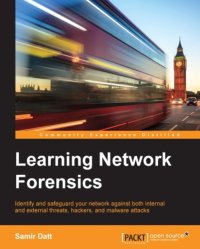
Ebook: Learning Network Forensics
Author: Datt Samir
- Tags: Business enterprises--Computer networks--Security measures, Computer crimes--Investigation, Computer networks--Security measures, Local area networks (Computer networks)--Security measures, Security, Local area networks (Computer networks) -- Security measures, Business enterprises -- Computer networks -- Security measures, Computer crimes -- Investigation, Computer networks -- Security measures
- Year: 2016
- Publisher: Packt Publishing
- City: Birmingham
- Language: English
- epub
Cover -- Copyright -- Credits -- About the Author -- About the Reviewers -- www.PacktPub.com -- Table of Contents -- Preface -- Chapter 1: Becoming Network 007s -- 007 characteristics in the network world -- Bond characteristics for getting to satisfactory completion of the case -- The TAARA methodology for network forensics -- Identifying threats to the enterprise -- Internal threats -- External threats -- Data breach surveys -- Locard's exchange principle -- Defining network forensics -- Differentiating between computer forensics and network forensics -- Strengthening our technical fundamentals -- The seven-layer model -- The TCP/IP model -- Understanding the concept of interconnection between networks/Internet -- Internet Protocol (IP) -- Structure of an IP packet -- Transmission Control Protocol (TCP) -- User Datagram Protocol (UDP) -- Internet application protocols -- Understanding network security -- Types of threats -- Internal threats -- External threats -- Network security goals -- Confidentiality -- Integrity -- Availability -- How are networks exploited? -- Digital footprints -- Summary -- Chapter 2: Laying Hands on the Evidence -- Identifying sources of evidence -- Evidence obtainable from within the network -- Evidence from outside the network -- Learning to handle the evidence -- Rules for the collection of digital evidence -- Rule 1: never mishandle the evidence -- Rule 2: never work on the original evidence or system -- Rule 3: document everything -- Collecting network traffic using tcpdump -- Installing tcpdump -- Understanding tcpdump command parameters -- Capturing network traffic using tcpdump -- Collecting network traffic using Wireshark -- Using Wireshark -- Collecting network logs -- Acquiring memory using FTK Imager -- Summary -- Chapter 3: Capturing & Analyzing Data Packets -- Tapping into network traffic.;Identify and safeguard your network against both internal and external threats, hackers, and malware attacksAbout This Book Lay your hands on physical and virtual evidence to understand the sort of crime committed by capturing and analyzing network traffic Connect the dots by understanding web proxies, firewalls, and routers to close in on your suspect A hands-on guide to help you solve your case with malware forensic methods and network behaviorsWho This Book Is ForIf you are a network administrator, system administrator, information security, or forensics professional and wish to learn network forensic to track the intrusions through network-based evidence, then this book is for you. Basic knowledge of Linux and networking concepts is expected. What You Will Learn Understand Internetworking, sources of network-based evidence and other basic technical fundamentals, including the tools that will be used throughout the book Acquire evidence using traffic acquisition software and know how to manage and handle the evidence Perform packet analysis by capturing and collecting data, along with content analysis Locate wireless devices, as well as capturing and analyzing wireless traffic data packets Implement protocol analysis and content matching; acquire evidence from NIDS/NIPS Act upon the data and evidence gathered by being able to connect the dots and draw links between various events Apply logging and interfaces, along with analyzing web proxies and understanding encrypted web traffic Use IOCs (Indicators of Compromise) and build real-world forensic solutions, dealing with malwareIn DetailWe live in a highly networked world. Every digital devicephone, tablet, or computer is connected to each other, in one way or another. In this new age of connected networks, there is network crime. Network forensics is the brave new frontier of digital investigation and information security professionals to extend their abilities to catch miscreants on the network. The book starts with an introduction to the world of network forensics and investigations. You will begin by getting an understanding of how to gather both physical and virtual evidence, intercepting and analyzing network data, wireless data packets, investigating intrusions, and so on. You will further explore the technology, tools, and investigating methods using malware forensics, network tunneling, and behaviors. By the end of the book, you will gain a complete understanding of how to successfully close a case. Style and approachAn easy-to-follow book filled with real-world case studies and applications. Each topic is explained along with all the practical tools and software needed, allowing the reader to use a completely hands-on approach.
Download the book Learning Network Forensics for free or read online
Continue reading on any device:

Last viewed books
Related books
{related-news}
Comments (0)